 SNOW HYDROLOGY (GEOG 4321): AVALANCHES
SNOW HYDROLOGY (GEOG 4321): AVALANCHES
Instuctor: Mark Williams
Telephone: 492-4794 or 492-8830
Readings
- Avalanche Handbook, chapters 4-7.
- Avalanche Handbook, all appendices.
- Hardy, D., M. W. Williams, and C. Escobar,
Near-surface faceted crystals and avalanche dynamics
in high-elevation, tropical mountains of Bolivia,
Cold Regions Science and Technology,
33 (2-3), 291-302, 2001.
pdf file of manuscript text;
and figures.
-
PPT presentation: Required reading
-
Nice examples of pits and slides from Utah Avalanche Center: Suggested reading
-
Great overview: Suggested reading
-
Mathematical approach to avalanches: Extra reading for those who want more
Animated Avalanches
Definitions
Slab Morphology
Avalanche Motion
Stability Evaluation
Hasty Search
Hydrology
Additional References
Avalanche Animation 1
Avalanche Animation 2
Silverton, Colorado, January 04
Avalanche account: read this story!
- Avalanche area
is a location with one or
more avalanche paths.
- Avalanche path
is a fixed locality within which avalanches move.
Distance may vary from 50 meters to more than 2,000 meters.
- Starting zone
is the location where unstable snow failed and
began to move.
Generally, the avalanche gains mass within the
starting zone and accelerates through the starting
zone.
Slope anlges in starting zones are often 30-45 degrees.
- Track
or zone of transition is the slope below the starting
zone that connects the starting zone with runout zone.
The avalanche mass generally remains constant.
The avalanche no longer accelerates and velocity remains
constant.
Generally the highest avalanche speeds are attained in
the track.
The slope angle is generally between 20 to 30 degrees.
- Runout zone
or zone of deposition is the area where deceleration is
rapid, debris is deposited, and the avalanche stops.
Slope angle often less than 20 degrees.
- Types of Avalanches
- Point Release
or sloughs are generally composed of loose snow.
- Snow is cohesionless.
- Avalanche starts at a point.
- Spreads downhill laterally, forming
an inverted V-shape.
- Involves only surface snow.
- Slab Avalanche
is the catastrophic failure of cohesive snow.
- Powder Avalanches
Most or all of the material in the avalanche
is suspended above the ground by turbulent eddies.
- Dry Slabs
Cohesive material has no or little liquid water and
a "core" of higher density snow in contact with
the ground.
A hard slab
moves as a cohesive unit downslope and a
soft slab breaks up immediately into
small blocks.
- Wet Slabs
Liquid water present.
Much higher friction at the sliding surface,
often "plowing" into the soft sliding surface,
causing the formation of grooves in the sliding
surface and also entraining rocks, dirt, and
other materials.
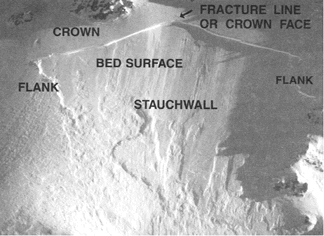
- Crown surface.
The top fracture surface of the slab.
Perpendicular to the slope.
- Crown.
Snow remaining on the slope above the crown surface.
- Flank.
Sides of the slab, often with a sawtoothed, jagged
appearance.
- Bed Surface.
Snow remaining below the bottom of the slab.
Main sliding surface of the slab.
Generally has a smooth appearance because of
friction from the sliding slab.
- Stauchwall.
Downslope wall of the slab.
Often wedge-shaped, usually obliterated by the
slab.
Snow is a unique material. It's a solid which exists close to its melting point. As a result,
snow can be elastic, viscous, and brittle.
Viscous deformation in snow is similar to the processes that cause folds in mountain systems.
Brittle deformation is when the substance breaks, such as a fault in mountain systems.
Snow has the ability to deform both viscously and elastically
before brittle failure occurs.
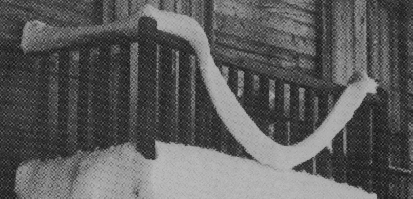
Elastic deformation means that when force is applied to the snowpack,
it deforms and when the force is removed, the snowpack returns to its original shape.
Snow has a limited ability to recover from compression.
The strain is relieved by elongation: viscous deformation.
Viscous means that force causes the snowpack to deform without breaking and
does not return to its original shape when the force is removed.
Snow has both those properties.
Snow is often termed a visco-elastic substance because of those properties.
However, there is a limit to these properties.
Snow won't indefinitely elongate, which leads to brittle failure and fractures.
When snow does fracture, some of that energy is transmitted through the snowpack
elastically. When that happens, the elastic energy can start avalanches on
nearby slopes: sympathetic releases.
Like all materials, snow can fracture when loaded in tension, compression or shear. And like most
materials, snow has substantial resistance to fracture in compression, BUT IS EASILY
FRACTURED IN TENSION!
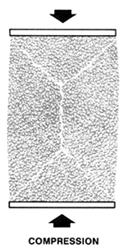

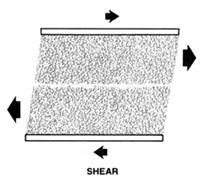
In COMPRESSION, potential fracture surfaces are pushed together
and the snowpack may gain strength. Additionally, forcing grains together "age hardens" the snow,
accelerating bonding between crystals. If there's a weak layer within the snowpack, the pack may
not glide as a cohesive unit, but SHEAR off along this layer.
Creep and glide accentuate the tensile forces within an inclined snowpack
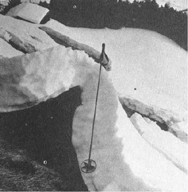
Creep is when the snowpack moves at different velocities under the
influence of gravity. Generally the bottom of the snowpack does not move
and motion (and velocity) increase with height in the snowpack.
The usual approach to modelling creep behavior is to ap-ply a constitutive
law that relates the bulk response of the
snow to anapplied stress.
For snow on a 36 šslope we expect the shearing component of
motion would be about 50% greater than the compressive
component.
Glide is when the entire snowpack moves under the influence of gravity.
Generally, as the surface roughness of the ground decreases, glide increases
for a given slope angle.
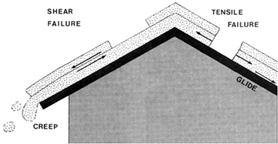
Nice example of these forces on a roof.
FLOWING AVALANCHES have a core and a dust cloud.
- The core is a relatively high density material
composed of snow particles and air locatd at the
bottom of the avalanche.
The height of the core is usually less than 5 meters.
Density of the core is somewhere around 35%.
- The dust cloud is composed primarily of air with
suspended snow particles and surrounds the exterior
of the core.
The height of the dust cloud can be tens of meters.
The density of the dust cloud is usually less than
1%, eg air makes up more than 99% of the core.
POWDER AVALANCHES Have a dust cloud with no core.
Often form by falling ice from steep snowfalls.
SHEAR STRESS (tau)

- rho is density
- H is snow depth
- g is gravity
- theta is the slope angle
AVALANCHE VELOCITY (V)

- zeta = coefficient of turbulent friction
- R is the hydraulic radius
- mu is the coefficient of kinetic friction at the bed surface
typical speeds
TYPE V (m/s)
powder 20-70
flowing 15-60
wet 5-30
AVALANCHE IMPACT PRESSURE (I)
I = rho V2
- rho is the snow density
- v is avalanche velocity
Impact forces as a function of avlanche type
Impact
force of an avalanche is determined by its speed, types and concentration of
entrained materials, flowing densities and dimensions. Using these parameters
we can evaluate the impact forces of different type of avalanches.
| Avalanche
Type |
Mean
Impact Force
(ton/m2) |
Flow
Density
(kg/m3) |
Concentration of Solid Material
(%) |
Typical Deposit Densities
(kg/m3) |
|
Powder Avalanche |
0.2-10 |
1-10 |
0-1 |
100-200 |
|
Wet Avalanche |
30-40 |
150-200 |
30-50 |
500-1000 |
|
Dry Snow Avalanche |
5-30 |
100-150 |
30-50 |
200-500 |
| Impact
Pressure (Ton) |
Potential Damage |
|
0.1 |
Break windows |
|
0.5 |
Push in doors |
|
3 |
Destroy wood-framed structures |
|
10 |
Uproot mature spruce |
|
100 |
Move reinforced-concrete structures |
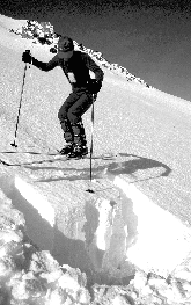
Rutschblok Test.
After digging a pit and examining the snowpack layers,
then isolating a
section as wide as a ski,
Robert Bland performs the last step in the Rutschblok test.
This is but one piece of information in determining snowpack stability,
and certainly not the only factor to consider.
CLASS I: STABILITY FACTORS
Current Avalanche Activity
Loading Tests
Fracture Propagation
CLASS II: SNOWPACK FACTORS
Past Avalanche Activity
Snowpack Depth
Slope Use
Ram Penetrometer
Snow Temperature
Snowpack Profile
CLASS III: METEOROLOGICAL FACTORS
Surface Conditions
Depth and Water Equivalent of New Snow
Type of New Snow
Density of New Snow
Snowfall Intensity (> 2.5 cm/hr)
Maximum Precipitation Intensity (> 0.5 cm/hr)
Settlement of New Snow
Wind Speed
Wind Direction
Air Temperature
Relative Humidity
Solar Radiation (slope and aspect)
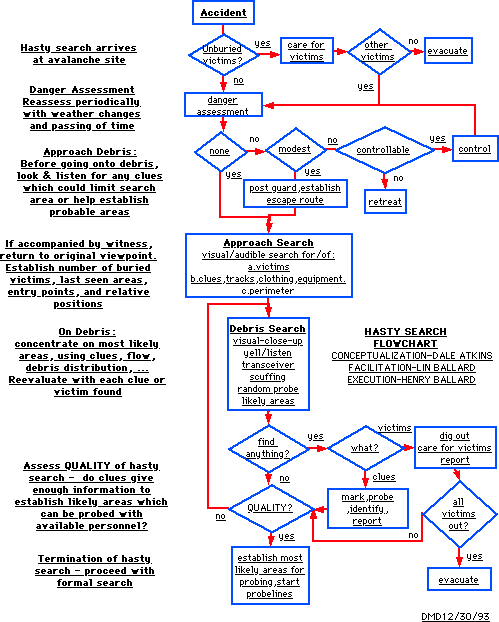
1993 Flowchart by Dale Atkins and Lin Ballard.
- Required reading (under selected readings in library):
Williams and Clow, Hydrologic and biologic consequences
of an avalanche striking an ice-covered lake,
Proceedings of the Western Snow Conference, 1990.
- Required reading (under selected readings in library):
Williams and others, Aquatic ecology as a function
of avalanche runout into an alpine lake,
International Snow Science Workshop.
- Recommended reading:
F. A. de Scally, Hydrologic roles of snow avalanches
in High-Mountain environments, pp 69-80,
Proceedings of the Western Snow Conference, 1996.
Gallatin National Forest Avalanche Center Home Page .
An excellent web site maintained by Karl Birkeland.
Stability Tests
Rutshblock Test
- Fohn, P, The "rutschblock" as a practical tool
for slope stability evaluation.
In: Avalanche formation, movement, and effects.
IAHS Publ 162, pp 223-228, 1987.
- Fohn, P, Snowcover stability tests and the areal
variability of snow strength. In:
Proceedings of the 1988 International Snow Science
Workshop, Whistler, BC, Canada, pp 262-273, 1988.
- Jamieson, J. B. and C. D. Johnston, Experience with
Rutschblocks,
Proceedings of the 1992 International Snow Science
Workshop, Breckenridge, CO, pp 150-159, 1992.
- Jamieson, J. B. and C. D. Johnston, Rutschblock precision,
technique variations and limitations,
Journal of Glaciology, V 39, pp 666-674, 1993.
Stuffblock Snow Stability Test
- Birkeland, K. and R. Johnson,
The Stuffblock Snow Stability Test
Special Report 9623-2836-MTDC,
USDA Forest Service, Technology and
Development Center, Missoula, Montana, 1996.
- Johnson, R. and K. Birkeland,
The stuffblock: a simple and effective snow stability test.
In: Proceedings of the 1994 International Snow Science
Workshop, Snowbird, UT, pp 518-526, 1994.
Shovel Shear Test
- Shaerer, P, Evaluation of the shovel shear test.
Proceedings of the 1988 International Snow Science
Workshop, Whistler, BC, Canada, pp 274-276, 1988.
 SNOW HYDROLOGY (GEOG 4321): AVALANCHES
SNOW HYDROLOGY (GEOG 4321): AVALANCHES  SNOW HYDROLOGY (GEOG 4321): AVALANCHES
SNOW HYDROLOGY (GEOG 4321): AVALANCHES 








